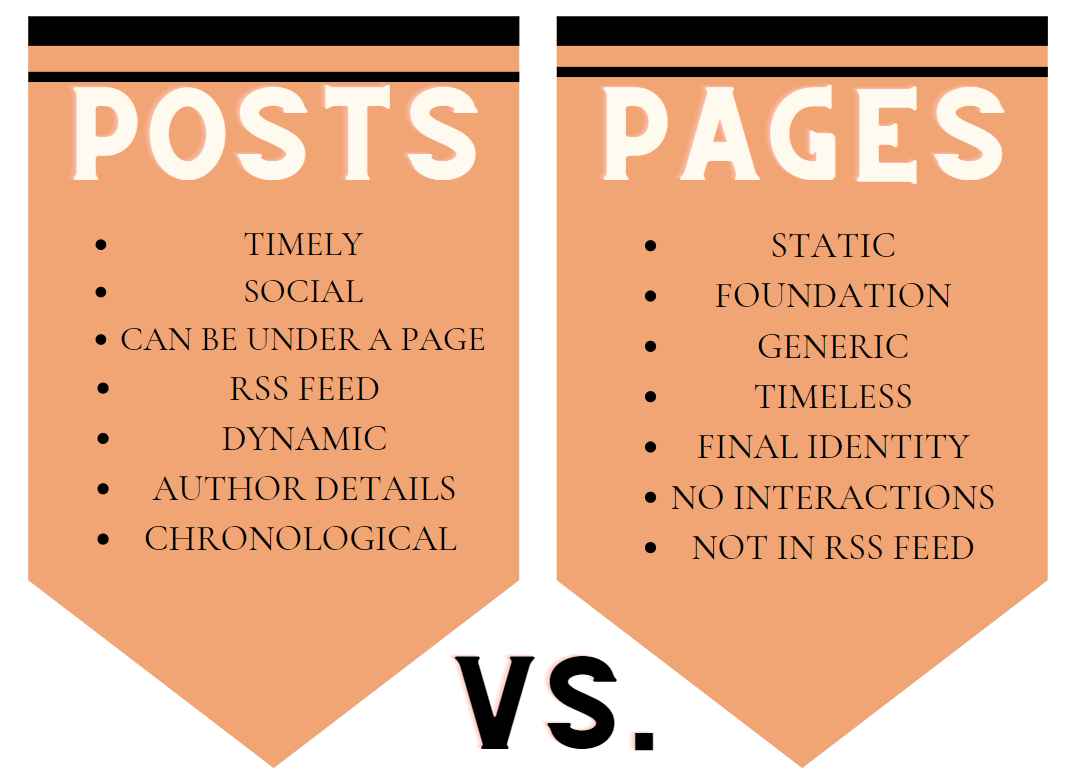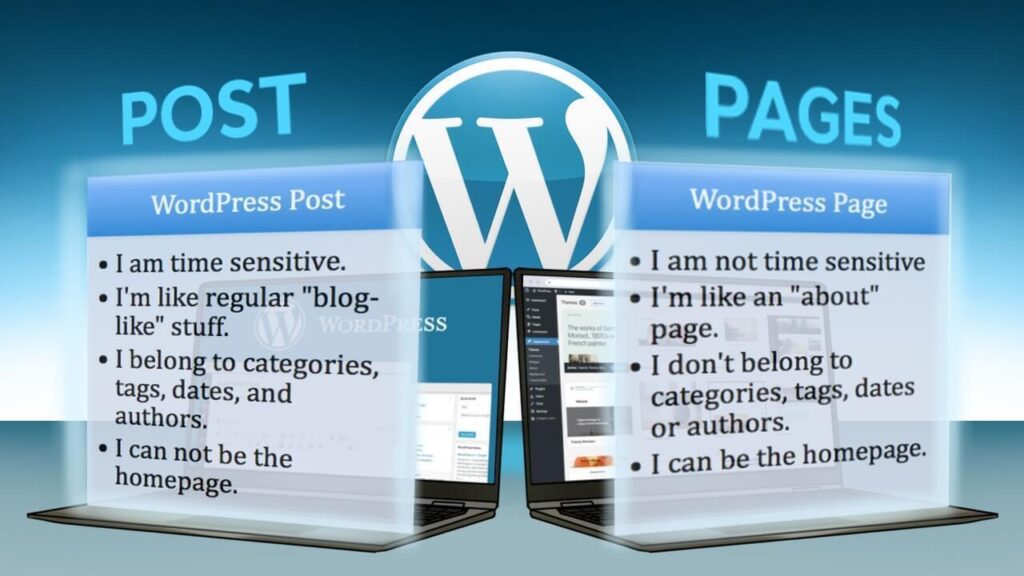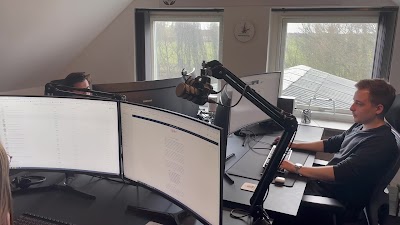Pages and posts almost look the same physically, which leads to confusion especially if you are just starting to make a website and using WordPress. But pages and posts are two different things and they differ in their own different ways.
Pages are the generic stored static content that is on your website. Posts on the other hand are the dynamic contents that are published on your website.
Find out what are the differences between the two and never be confused about which is which anymore.
What are the differences Between WordPress Pages and WordPress Posts?

The distinction between Posts and Pages might be a little bit confusing. Especially physically when seen on websites and in terms of physical aspects, it is safe to say that Pages and Posts are two very different things!
What are the differences between the two and what are they unique from each other? Here are 7 of each difference between pages and posts.
WordPress Posts
Timely
Posts are timely. This means that this type of content is most of the time based on what is trending and what is in. Because posts are often based on what are things that are relevant depending on the line of industry of the website.
For example, your website is all about the “Top 10”, and this month the New York Film Festival will be held. This means that you can post about the top 10 films in the NYFF. Or for example, you sell cosmetics and it is already the Christmas season. Your new product will be released so you post a blog that introduces the story behind the new product which is connected to Christmas. The blog contains why the products are named like that, and how they came to your mind, with layouts relevant to the theme of Christmas.
That is one characteristic of posts, it is always timely when it is being published!
Social
Another attribute of posts is that they are social. Most of the time, posts encourage interaction or at least allow visitors to leave comments. This is one thing that pages never do, there is no way that pages allow interaction. Posts can be two-way, the users receive something from the post and then are allowed to leave comments. But pages are lonely one way, they just give information, the end.
Can be Under a Page
Posts are basically under pages and categories. This way, it is organized. Let’s use the example above again, let’s say you own the “Top 10” website. Obviously, there will be a lot of top 10 things you will write about, so you will have to organize them into categories. Posts will always be under categories or pages for the sake of organization.
For example, you have three categories ( which for sure there will be a lot but let’s use there for example). Food, movies, clothes. Let’s say you have a “Blogs” page, and under that page are the categories, and under those categories are the posts.
RSS Feed
Staying current with the sites of your top choice, including blogs or online magazines, is simple with RSS Feeds. If a website gives an RSS feed, users are alerted every time a new article is made and can choose to see the full content or just a synopsis.
RSS feed works basically very much like the notification bell button on YouTube. There will be a notification that lets users know that there is a new post from their favorite website. And obviously, posts are the star of the RSS feed. Pages are not included in this.
Dynamic
From the word itself, which means ever-changing. Posts do not have one identity, every post has a different identity every time one is published. It is because posts like those mentioned above should be timely and relevant, it should align with what is currently sound in the industry or line of the website.
Posts are different, every single one of the posts varies because trends also change from day to day. And the goal of posts is to be seen and spark the interest of the readers or audiences, which means they have to be interesting.
Another meaning of dynamic is that it can be a different type of multimedia. For example, posts can be blog posts, a video, an infographic, audio files and etc. Depends on what the website needs.
Keep in mind that posts can be anything, they change from topics to the type of multimedia.
Author Details
This is also one of the biggest factors that separate the two. Posts most of the time include the details of the authors, especially the blog posts. It also has the date when it was published. You know that spot when you read blog posts when you see information like “About the author” and then it talks about the hobbies of the author, where he or she went to college, some of her relevant experiences and etc. You will certainly not find one of those on a page.
Chronological
Posts appear in chronological order. The newest posts are the ones that will appear at the top of the site when people search for example. If the search they are looking for happened to be posted let’s say months ago, they would have to do a scavenger hunt to find it.
Since most of the time there are a lot of posts on a website, therefore it will not be easy to find the ones that have been published way back if they do not search on Google. They might have to scroll or map the website to find what they are looking for.
WordPress Pages
Foundation
Pages are the pillars of your website. They are important to have on your website, these are the ones you work on as a starter for your website. For example, the “About” page should have the history, team, missions and vision and etc. The pages of your website are what will make it stand as a single website.
Others use the term “parental” page. If posts are usually under the organizational chart, pages are always on top and are always above, that is non-negotiable.
Generic
The content of the pages is most of the time alike. Pages are the ones that you will work on first especially when you are just building your website. Especially the legal pages, the “about” page, and the others. It is because they are the building blocks of your website, categories and posts follow after the pages are laid well.
It is considered generic because websites literally have the same pages, for example, you will see most of the websites have these pages:
- Homepage
- About Page
- Help Page
- Join Us Page
- Contact Page
- Product Page
- Blog Page
- Legal Pages (which are a pre-requisite)
These are the most common pages that you will see that most websites. Why? because as mentioned above, it is the foundation of the website. Of course, the contents themselves differ for every website, but the fact that all websites have the same basic and fundamental pages is what makes pages generic.
Timeless
This means that pages must be relevant at all times. Unlike posts, their relevance can change any time of the day every day, but pages are timeless. The timelessness of the pages is extreme. It is because of the fact that no matter when the visitors see these pages, it is still relevant, important, and aligned with the website.
For example, the “About” page, let’s say the mission and vision of your website, even when e visitor reads it tomorrow or 20 years from now, it will still be relevant. Why? Because those are the things that do not change. Other examples are history, the team and etc.
But that doesn’t mean that it should not be updated. For example, if you got a new team member, of course, that member should be added to the pages. Or if your contact number changed, it should be updated.
But remember this, pages are relevant because their importance never ceases and never changes.
Final Identity
Posts have different identities every single one is published, but pages have one final identity. A post can have humor incorporated into it, or it can change the tone from time to time depending on the goal of every post. But pages have only one identity. For example, the legal pages, it has only one identity and focuses on the legal system aspect of the website. The about pages focus on letting the visitor know more about the website, its history, the people behind it and etc. And it doesn’t change, it will never change. Whereas posts change daily, while pages stay solid in their identity over time.
No Interactions
Posts can have interactions in them, authors can allow visitors to comment and leave their insights or other suggestions regarding the post. But legal pages never have that privilege to interact. All the readers can do is take from the pages and never do anything about it. If interaction will be allowed on pages, it makes it a post.
It is good that the foundation of the websites (which are pages) does not need the opinion of visitors. This one is kind of sewn on the website. No comment or opinion can change, and no interaction is allowed.
Static
Any type of file can be used as static content as far as it doesn’t adapt to user intervention or behaviors. And pages do not adjust in any way to the behavior of the website visitors. That is why on pages, interactions are not allowed and are not built for social purposes. Pages do not adjust for anything, other than the actual needs of the website itself. Therefore, it is considered static content.
Even when there is little or much traffic on your website, it doesn’t matter. Your pages will stay the same and will not change a bit. But if we will talk about posts, and there is very little traffic, in goes these responses:
- Change the approach of the content to something more interesting
- Incorporating trends
- Check what is the biggest performing post and make more of those
- Look at the statistics of the visitors and look at who are the majority of them and make posts that resonate with them
But your pages, whatever happens, will stay the same (unless they need to be updated). The behavior of the visitors will not affect the pages of your website, but the posts surely will because that is where they depend.
Not in RSS Feed
When a favorite website publishes a post, people get notified when they send an RSS feed, and pages are not included in those content. Pages are like businesses that do not need marketing because people already know that they exist, where to find them, and that they are important.
RSS is basically marketing or promotion for the posts on websites and online magazines, and pages do not need them. Website visitors know that pages exist, they know where to look for them and they know that those pages are important.
Even if pages are not in the RSS feed, the importance and relevance of the pages remain unshaken, because pages are vital elements of a website that needs no promotion, because people know about them.
Objective
This is the thickest line that separates these two, the objective. They have very different characteristics that make them unique from each other. But the biggest thing that separates them is their objectives, what are their purpose for the website.
The objective of the Pages
Pages are built to keep the identity of the website. Whilst producing a lot of posts that have different topics and identity in it, pages are the fundamentals that are embedded in the website to keep the identity website. The pages of a website are what stay the same whatever happens to the website, the analytics, the traffic and etc.
The objective of the Posts
While the pages are the identity keepers of the website, the posts are the frontline workers. Posts are the ones that drive traffic to websites, interact with the leads, and even help with sales. Posts are the ones that move more people to the website.
In the end, each of them serves a different purpose and both are great and important for the website. Pages are consistent while posts are dynamic and spontaneous. That being said, you should make both excellent pages and posts for your website to experience optimal results!









